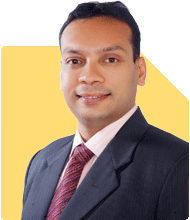Ramalingam Kalirajan |2419 Answers |Ask -Follow
Mutual Funds, Financial Planning Expert - Answered on May 01, 2024
He has an MBA in finance from the University of Madras and is a certified financial planner.
He is the director and chief financial planner at Holistic Investment, a Chennai-based firm that offers financial planning and wealth management advice.... more

Hello sir,i wish to invest in SIP with direct growth. Choosen 1 best in each small cap, mid cap,large csp, flexi cap and psu. In which platform shall i start all thiese to make sip mandate as collective? Suggest me a reliable and safe one
But worry not, fellow investor! Many reliable and safe platforms allow you to set up SIP mandates across different fund houses. Look for platforms with a user-friendly interface, good investment research tools, and transparent fees. Imagine it as your handy travel planner - easy to navigate, informative, and keeping costs sensible!
A Certified Financial Planner can be a great partner on this journey. They can help you shortlist funds based on your risk tolerance and goals, ensuring your chosen companions complement each other throughout the market's ups and downs. Think of them as experienced travel advisors, making sure your investment adventure is well-planned and enjoyable!
You may like to see similar questions and answers below
Nikunj Saraf |308 Answers |Ask -Follow
Mutual Funds Expert - Answered on Oct 21, 2022
Nikunj Saraf |308 Answers |Ask -Follow
Mutual Funds Expert - Answered on Mar 06, 2023
Ramalingam Kalirajan |2419 Answers |Ask -Follow
Mutual Funds, Financial Planning Expert - Answered on May 06, 2024
Ramalingam Kalirajan |2419 Answers |Ask -Follow
Mutual Funds, Financial Planning Expert - Answered on May 03, 2024
Krishna Kumar |281 Answers |Ask -Follow
Workplace Expert - Answered on May 17, 2024
Ramalingam Kalirajan |2419 Answers |Ask -Follow
Mutual Funds, Financial Planning Expert - Answered on May 17, 2024
Ramalingam Kalirajan |2419 Answers |Ask -Follow
Mutual Funds, Financial Planning Expert - Answered on May 17, 2024
Ramalingam Kalirajan |2419 Answers |Ask -Follow
Mutual Funds, Financial Planning Expert - Answered on May 17, 2024
Ramalingam Kalirajan |2419 Answers |Ask -Follow
Mutual Funds, Financial Planning Expert - Answered on May 17, 2024
Ramalingam Kalirajan |2419 Answers |Ask -Follow
Mutual Funds, Financial Planning Expert - Answered on May 17, 2024
Ramalingam Kalirajan |2419 Answers |Ask -Follow
Mutual Funds, Financial Planning Expert - Answered on May 17, 2024
Ramalingam Kalirajan |2419 Answers |Ask -Follow
Mutual Funds, Financial Planning Expert - Answered on May 17, 2024
Ramalingam Kalirajan |2419 Answers |Ask -Follow
Mutual Funds, Financial Planning Expert - Answered on May 17, 2024
Ramalingam Kalirajan |2419 Answers |Ask -Follow
Mutual Funds, Financial Planning Expert - Answered on May 17, 2024




















